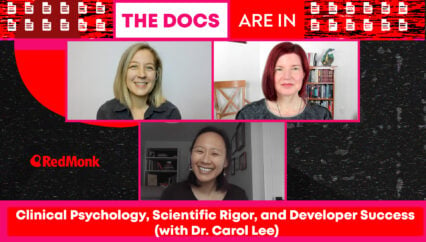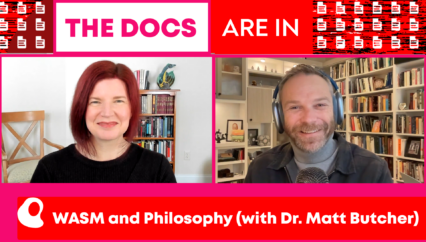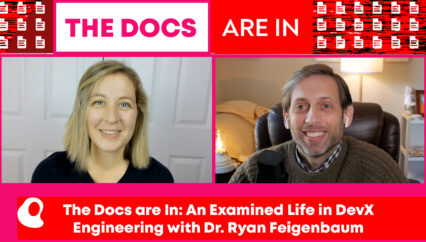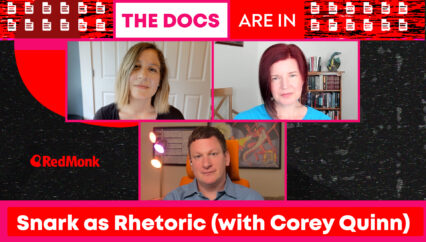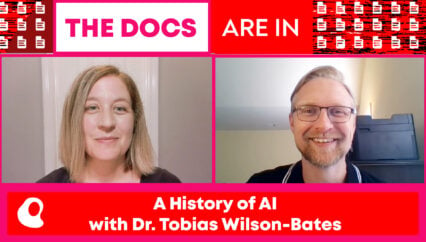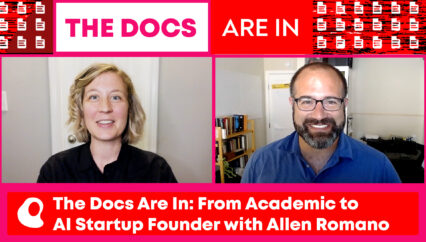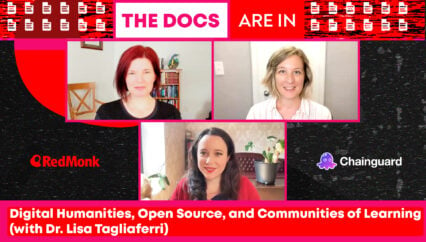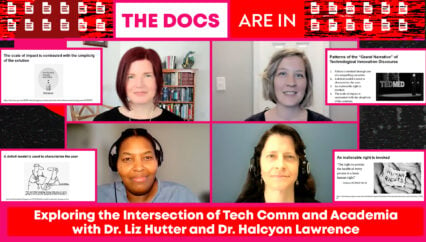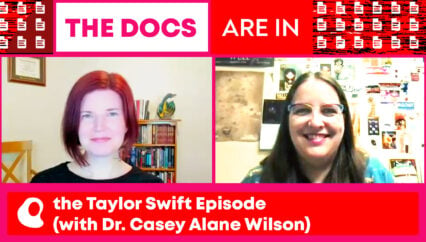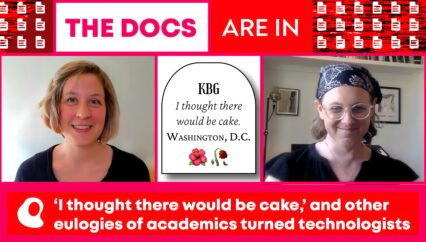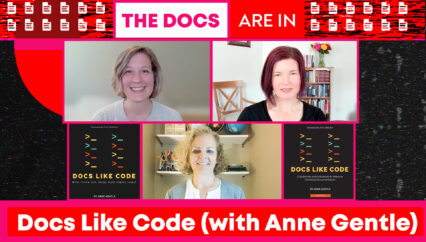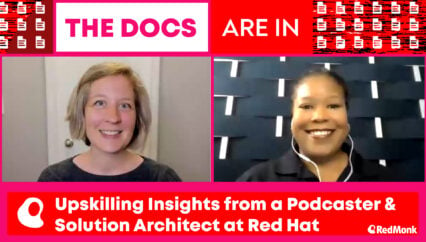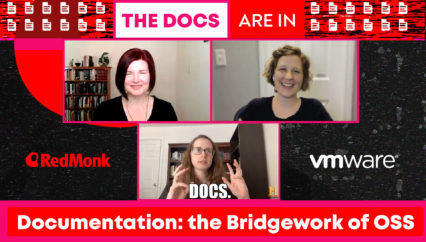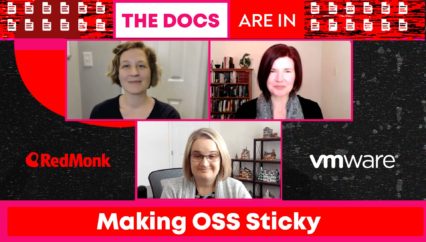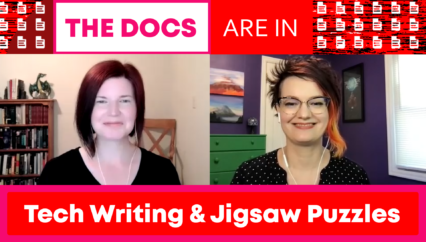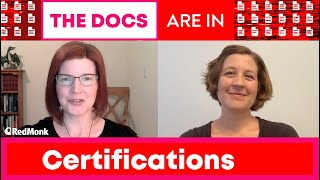In this Docs are In conversation, RedMonk senior analysts KellyAnn Fitzpatrick and Kate Holterhoff chat with Dr. Rebekah Greene, assistant professor at the University of Rochester School of Nursing. Dr. Greene elaborates on her responsibilities in this role and how her as a scholar of 19th century literature actually dovetails and supports her work in clinical nursing. They also discuss the importance of technical communication to the medical profession, and share some strategies and best practices for fostering patient-medical professional communication.
Resources
- Rebekah’s University of Rochester faculty page
- Rebekah’s list of communication and nursing education resources
Rather listen to this conversation as a podcast?
Transcript
Kelly Fitzpatrick: Hello and welcome. This is Kelly Fitzpatrick with RedMonk, here with my excellent colleague and co host, Dr. Kate Holterhoff. This is The Docs are In, where we sometimes talk about Tech Comm and documentation and sometimes talk to folks with doctorates. Today we’ll be doing both. And our topic, how Tech Comm matters in the profession of nursing. Our guest is a former Georgia Tech colleague of both Kate’s and mine, Dr. Rebekah Greene, who is Assistant Clinical Professor of Nursing and Instructional Designer at the University of Rochester School of Nursing. Rebekah, thank you so much for joining us today. I know it’s mid semester for you and you’re really, really busy, but to start things off, can you tell us a little bit about who you are and what you do?
Rebekah Greene: Sure. Thank you both for inviting me to join The Docs Are In today. I’ve been a fan for a while and I’m very grateful to be here right now. My title, as you mentioned, is Assistant Professor of Clinical Nursing at the University of Rochester School of Nursing. This basically means I wear multiple hats. I co teach our undergraduate and graduate research writing courses every single semester, so fall, spring, and summer. And it’s wonderful because I get to have an impact on every student who goes through any of our programs. I also am an instructional designer with our Doctor of Nursing practice program, which is really exciting because it means I get to help as we embrace new technologies and embrace some of the capabilities of older technologies. So we’re in the process right now of upgrading one of our LMS platforms, and that’s been a very interesting challenge. I am also involved with assessment and accreditation efforts and got to be part of the documentation and writing team for that recent effort we passed, which was very exciting. I got to collect a lot of data and interpret data and not only was able to participate as the primary writer for the first two drafts of the entire report, also spent a lot of time trying to cheerlead my colleagues to let them know that you do have an exciting story to tell about what you’re accomplishing here.
Oh, I forgot another interesting role. I am also one of our writing coaches in our center for academic and professional services. So if someone needs help with, for instance, they’re an English language learner or an ELL student, we used to refer to those folks as English as second language students. But one of my frequent flyers, English is, I believe, her 8th language learned in a refugee camp. So I’m here to support all of those folks to the best of my abilities. So basically, sometimes I wear too many hats. There’s lots of plates spinning in the air. Our dean has a saying she regularly uses, that many times it feels a little bit like we are flying a jet while we’re building it. And that’s actually one of the things that attracted me to the school of nursing. I am blessed to be in this role.
Kate Holterhoff: So, you’ve already told us a bit about where you are, but I’d also like our audience to hear about your path to your current job, because, as we know, it is fascinating. And your PhD was in English literature, 19th century British literature, in fact, which was also what I studied at Carnegie Mellon. So it is near and dear to my heart, and it would be remiss of me not to dig into this subject a little bit more. So, can you talk about, like, that part of your background and, like, how it relates to what you’re doing today?
Rebekah: My primary emphases of study, I was actually very excited about how things work. So, for instance, in Treasure island, there’s this glorious moment where Jim Hawkins is worried because one of his mother’s residents at the inn she keeps, he hasn’t paid his bill and he’s just died. And Jim’s father has also just died. They need cash. What is in this mysterious sea chest that this man has kept locked? Right? So Jim goes in and he just starts making an inventory of all of this stuff. And long story short, I’ve always been fascinated by inventories of how things…Inventories of things, and trying to think about how things work and how do we tell others about how these things work. So, one of the things that’s always delighted me about adventure literature is that many 19th century British novelists who were experimenting with this genre were trained as engineers, lawyers. Anthony Hope, who wrote The Prisoner of Zenda, he was a lawyer, Stevenson was an engineer and a lawyer by training. And then Arthur Conan Doyle, best known for Sherlock Holmes, he’s trained as a medical doctor. His specialty’s in Ophthalmology. And all of these guys start writing adventure stories because they want to know how things work. And how do you tell other people about how things work?
I’ve always been fascinated by how things work. And pre financial crisis, I was actually working in the worlds of banking and small business development. Pre-coming to that journey, I had actually worked as an undergrad in a call center where we could earn paid time off if we built the database of various products, measurements, lists of ingredients. We’re talking on, like, old IBM terminals here. So this was for PetSmart. When they were first trying to go online. I was really attracted to that idea of paid time off. Started perhaps going a little overboard on the documentation, and then that led to an invitation to join their customer service newsletter team and to start training people on the floor. So at this point in my life, I had no idea about like, oh, you should be a teacher. But that was kind of the moment that opened that door. They paid for me to go to undergrad on the stipulation that I earned a degree in business. While I was taking one of those business courses, a colleague said, hey, I’ve noticed that you’re a really good teacher and we need that at the bank I currently work at.
So that was how I kind of shifted over into the world of business. Then 2008 happened and I decided, oh, this is a lovely moment to take that little settlement. See if you can get into grad school and start exploring thoughts about what gives you joy. Fast forward a few years. Because of all of that experience in my previous roles, I was offered the opportunity to start teaching business writing while I was a graduate student. And then that started transforming into some additional part time roles, writing documentation and then post Brittain fellowship. Already had a pretty good understanding of instructional design elements, adult learning theory, the importance of good documentation, and was working at that point in time for a higher ed technology company, doing a lot of teach the trainer type activities, and large group seminars for faculty.
But then a merger happened. And although I was promoted, which was very exciting, there were some problems with the corporate culture that I just wasn’t happy with during the merger. So I decided that I wanted to just start sending my resume out and seeing if I could find some nibbles. Applied to an instructional design role at the School of nursing. Received a very lovely interview, thought things were great. Loved the team. Received a call back the next day saying, we can’t afford you. You have too many skills. But don’t worry, we’ll workshop your resume around campus and then flash forward about six months. I receive another promotion at my then job, and it’s the school of nursing saying that they have all of these needs. They have reviewed my resume and gosh, this is great. You can fill five different roles. So hopefully I answered the question.
Kelly: Am I correct in remembering that they created your current job role for you?
Rebekah: That is correct. The then administrative assistant who had to enter the material into the human resources system, they created my role using the appropriate job codes and documentation, but then they actually had to also create a separate Word document stating what the job roles were and the job, that Word document was saved as Rebekah Greene job.docx. So if you went in and tried to apply to the job, that was the file that populated. And that’s. I’ve saved a copy of that because that story has just always made me laugh. And yes, the job was created for me, which is something I have to think about.
Kelly: That should happen more often. Because often universities will post these jobs and everyone applies to them not knowing that they were created specifically to hire a person. Whereas, like, anyone going in is like, I’m not Rebekah Greene, this is not my job.
Rebekah: Right. And I’m still flattered by this. I know that there were people behind the scenes who expressed concern, but yeah, whenever I’m having a negative day or there’s a committee where I’m frustrated, I just remember, like, they picked you, they chose you. They decided you were the solution to all of these problems, now be the solution. So it’s a fair amount of pressure, but it’s good pressure.
Kelly: So carrying on this topic of all of the different hats that you wear, you have, I think, like at least two job titles, but it sounds you have five different jobs in there. How do all of these roles that you have interact with each other, and how does this serve the purpose of helping nurses learn to be better at being nurses?
Rebekah: What a wonderful question. And I think succinctly put, the associate dean for education, who I directly report to, when I first met with her for this job opportunity, told me that she sees communication at the heart of absolutely everything that is happening within the School of Nursing. We spend too much time in committees, not necessarily understanding the intent of what other people, who our peers are writing about or trying to explain. Our patients don’t always understand what nurses are telling them to do, especially at times like hospital discharge. If you’re feeling a little bit woozy and you’re still there in the wheelchair, are you really paying attention to the english only document in the eight point font? Probably not. You’re just, you know, where’s my ride? It’s cold. I have to go. So I really loved that. She very clearly saw clear communication as a key. Knows that our students sometimes struggle with trying to figure out what is the professional language that they are expected to speak in certain environments. And how do you essentially code switch between your professors, folks at work, your patients, your Aunt Betty, who wants to know how your day was. And how are all of these different forms of communication interrelated.
So I think, for me, when I work with students, one of the challenges that I regularly face, we kind of joke about this among the writing coaches. How do you translate the way that friends speak into something that is more professional that your boss could basically copy and paste into a grant proposal? So, one of my key jobs here is trying to help students understand the importance of audience and how you do complete that work of translation. So I think we’re, in many ways, the school is trying to figure out how all of my hats come together into one sort of extravagant 1950s style headpiece with, like, many feathers. But one of the things that gives me great joy is just that many folks here do see one hat instead of five hats. So it’s good for me to know that they can see that even at moments when I cannot.
Kate: Well, I want to drag this back to the 19th century, if you don’t mind.
Kelly: You would. As a Victorianist, yes.
Kate: I am who I am. So I got to understand. So the technical communication part of your background and your role currently seems so… I don’t know. It really just draws on such a great number of skill sets, right? So, I guess I’m curious, do you see any sort of through lines between your experience as a scholar of the 19th century and what you’re doing today? I mean, is there a sort of connection that you draw in your own mind when you’re thinking through these sort of disparate time periods, interests, discourses? You know, what is the connection there?
Rebekah: Oh, what a wonderful question. And thank you, Kate. For me, I definitely see that through line. One of the reasons I chose to study the Victorian period, when one of my grad school advisors finally told me, you have to pick a specialty. You can’t have all of the periods. You need a period. The main reason I chose the Victorians is because so many of them are typically middle class or professional class, and they genuinely are just interested in absorbing knowledge. They know that they’re part of a rapidly expanding world with all sorts of new technologies that can help make their lives better. But most importantly, they seem to understand that you need to understand other people’s perspectives. You need to be able to read and hopefully understand how something works. You need to hear other people tell their stories about things. So, one of my favorite — I’m definitely seeing the through lines right now because of a current project that I’m working on, on nursing education in the last 50 years or so of the 19th century. Because in the world of nursing, we acknowledge Florence Nightingale as kind of the queen bee and the originator of all good things nursing, where her true strengths lie, as she was trained by German nurses at a facility named Kaiserswerth, came back, translated the knowledge into English, started using her extensive social networks to think about, hold on. What are some of these things that these German ladies have told me a good nurse needs to do?
She’s reading scientific journals, trying to figure out about, oh, wait a minute, we have just discovered this thing called cholera. That does sound particularly nasty. What can we do to prevent this? And she is really starting to work on marketing nursing as a profession for respectable women. Her other greatest achievement, though, is that she knows that folks like members of parliament need extensive reports. So she’s willing to provide that documentation, because the British army officers may not have the time or capacity to write those reports. But she also understands that not everyone wants to read a long, boring report. So she starts playing with data visualization. And I’m just fascinated by the ways that she manages to draw all of these threads together and even years later, is still thinking about important issues like, wait a minute, how can we have nursing registries? What sort of retirement systems are there for people who are poorly paid and have dedicated their lives to the social good? And how do we leverage our own knowledge in ways that we can really work with policymakers to affect change?
So, long story short, Kate, there are threads, and I think those threads are really baked into and permeating everything that there is in the world of nursing education. That being said, I think it’s also important to note that there were also some, what we now recognize as classist and racist issues that were really baked into a lot of Florence Nightingale’s practices and then permeated throughout the profession because she was the fountainhead of all knowledge, right. So those are things I think we’re now starting to really grapple with behind the scenes. But, yeah, basically, long story short, Victorians, there is the thread, and it might be a tangled knot, but it’s our tangled knot. And by we, I mean that’s carried through to Victorianist. So you get the idea.
Kate: I do, indeed.
Kelly: Yeah and you started touching on some of this in your discussion of, like, what do the Victorians have to do with nursing? But in terms of nursing and technical communication, like, what other trends are ongoing that people should know about? And what problems are there that as kind of like a profession and having this almost like, academic eye towards it, are folks trying to solve?
Rebekah: Oh, where does one even start addressing this question, right?
Kate: That’s a big one.
Kelly: Like, pick your TL;DR, do your Florence Nightingale, what are the key points that we can pull out there?
Rebekah: Right. And I think one of the things that my Doctor of Nursing Practice students are always interested in is how do you delve deeper and start picking out the themes that matter the most? Basically, what needs to be triaged in this documentation immediately. And I think the biggest trends that we need to be aware of in terms of technical documentation are that many younger individuals currently going through both nursing school and medical school are starting to receive training in how to write in plain language. The National Institutes of Health have actually just dropped out a lovely new teaching toolkit on the importance of using plain language. But we still have a lot of medical professionals who write in professional jargon. Acronyms are still absolutely everywhere. And if you ever have gone into your own electronic medical health record, you’ve probably seen all sorts of interesting notes where you’re like, wait a minute, what is this doctor talking about? So, for instance, in my own EMHR, I recently went in and saw a note and was just like, I’m not sure what she’s talking about. Let me use Google. And basically she was using jargon to indicate that I had clear eyes with lots of white showing.
And I’m like, well, that’s exciting. Yes, we had been discussing blood pressure. That is pertinent to that conversation. But the fact that I had to use Google to try to translate this information is concerning. I’m a PhD. I work in the school of nursing. Theoretically, I should immediately know what this doctor has said in my chart. And too many patients don’t receive that information. One of the students I’m currently working with is actually trying to create a sort of educational tool by this, basically an eight and a half by eleven bullet pointed list for other patients on her floor, or, excuse me, for other nurses on her floor, working with patients that’s trying to help them understand that when you’re telling an older patient recovering from hip surgery, I need you to get up and ambulate ten paces, maybe we should translate that to plain language. I need you to please get up and walk ten steps, because not everybody has that language awareness, right? So that’s one big problem.
Another big problem is general cultural insensitivity, not knowing that there are certain signs where you should ask, excuse me, would you be comfortable if I got a translator for us to have this conversation? One of the problems with one of our area healthcare systems, right now is that there’s five additional primary languages other than English spoken in this geographic region. There’s currently no written, no complete set of discharge instructions that are pre translated into these languages. So they have to wait for a translator to basically come in and check Google translate. So that’s another big issue.
Kelly: And having been discharged from a hospital at some point in my life and having to deal with that in just English, which is like my first language, I can’t even imagine having to be in that state and then having to try to figure out how to parse through what is completely ineffective communication at that point.
Rebekah: Right. And I think for me, the real sadness and one of the primary reasons I took on this job is just thinking about those patients who are going through that process. Nurses regularly get frustrated because the patients aren’t complying with the instructions. But if you don’t understand what the instructions are and you don’t feel comfortable enough to ask for a little bit of clarity, of course you’re not going to comply. So it’s in many ways, it’s a real catch 22 situation that I think just having a little cultural humility and putting yourself in the other person’s shoes or even following that old golden rule idea would really help improve healthcare for the better.
Kate: As it is 2024, I think I have to ask here, is this an opportunity that AI can help us, or are you seeing AI kind of intersect with any other parts of your role at the university?
Rebekah: Ugh, AI…
Kelly: You knew we were going to ask. Like you knew we had to do it.
Kate: Sorry. You set me up!
Rebekah: It is true. And I think it’s fine. We are definitely, in my school at least, seen increased opportunities for AI, so we do a lot of patient simulation work. There’s some AI opportunities happening there that students and faculty are both responding to pretty positively. We have many faculty who don’t necessarily feel confident with writing discussion board prompts within their own classes. So some of our interesting learning tools like Harmonize, for instance, now have the ability for you to essentially put in a little bit of your idea about what you want students to do, and the AI will write your discussion board prompt for you. And that’s pretty good. It could probably use a little bit of adjustment. That’s my English PhD coming out right there. But I have noticed that it has been helpful with helping students do things like generate titles for papers, maybe organize their paragraphs a little bit more effectively. But we still have issues throughout, I think, with both faculty and students doing things like checking the sources that are cited by the AI. I recently had to correct a member of the overall University Higher Administration to indicate to them that, you know, your parenthetical citations don’t actually exist.
So that was kind of an awkward conversation to have. So I think it can help us save time, which is awesome. But we need to then always remember that you have to backtrack a little bit and make sure that it’s producing the results that we want it to. I think one of the things, though, that really fascinates me about AI right now is our faculty are desperate for policies on how to effectively use it in classroom settings, how to use it in patient care settings. They’re super excited. We sometimes have to remind them that it’s not ethical to put your student work into chatGPT 4 without their permission. And why are you putting it into some sort of AI thing anyway? What’s going on? What’s the greater purpose here? I love the spirit of creativity and curiosity that it’s generating right now. But as someone who is raised on a steady diet of nineties action movies, I can’t help but feel we’ve unleashed Skynet without understanding what Skynet can do. So I am cautiously optimistic about the potential of AI.
Kelly: I appreciate both your Skynet reference and your kind of assessment of the kind of curiosity component about AI. And Kate has always said AI is for tinkerers, so maybe that’s true even outside of the tech industry. It just goes beyond, into the greater world.
Rebekah: And I think for me, the reason why I am so cautiously optimistic about AI and our use thereof is there’s such a — our world currently lacks opportunities for creativity and joy and artistic expression. And if AI could help me do something that I didn’t like doing, like sorting and organizing my socks, welcome to my life, AI. I embrace you. But the fact that I could use AI right now to write a recipe for dinner or compose a song or write a sonnet. Boo! That’s stuff that I wish I had the time to do. Like go away. And I think back when I was teaching technical writing at Georgia Tech, I had a partnership with our poetry professor where we were doing an initiative around Atlanta where we were launching little poem machines into the wild. Students could share poems that they had found meaningful, and the technical documentation came into play with, the students had to write instructions for how the machines were supposed to work and then how to maintain them, and those results varied quite significantly.
But I just remember one student coming to class and he was a mess. He confessed he had been up for at least four days straight. He wasn’t sure how many more energy drinks he could hold. I’m just like, Danny, what is going on? And he had gone so overboard with this assignment that he was using early prototypes of chat GPT to write poems. And then he was going through and checking them to make sure that they had the correct scansion. And I’m just like, I appreciate you, but wow, this is like, you’re no longer in the solar system. Like, I need you to be back in the solar system. So again, he got so carried away with tinkering that he just needed someone to like, rein him back in.
Kelly: Yeah, like, we need to focus now. And on that note, so final question for you. What would be the TL;DR of advice that you would give folks looking to improve communication in the field of nursing?
Rebekah: There’s a few items here. I think my first one, my first bullet is, be curious. Second is ask questions. Three is if you don’t understand something, ask for help. Four, again, apply the golden rule, try to do unto others as you’d have done unto you. And then my final is use plain language. If someone is looking like they’re not getting it, ask them, are you understanding this? Try to rephrase the information that you’re giving them. And if they’re still looking befuddled, try to again see if you can rephrase that. It’s that sort of teach back concept. Right?
Kate: Sage advice as always. Well, I want to thank Dr. Greene for joining us on The Docs Are In today. Becky, are there any channels for folks to follow you in your infinite wisdom? Are you on any social media platforms and what’s the best way for folks to continue learning from your experience?
Rebekah: Oh gosh. I am actually on several social media platforms. I’ll include the LinkedIn link under separate cover, but I can be found on both Bluesky and Twitter @drrcgreene. Green has an e on the end. Promise to follow back, but you will be exposed to a sort of veritable rookery of interests should you choose to follow me. So come on board. And I enjoy critiquing technical documentation in the wild and really bad signage on those sites.
Kelly: And we’ll include your socials in the show notes along with, I think you gave us an extensive list of resources that folks who are interested in tech comm and nursing can check out. So we’ll put those in the show notes as well. I’d like to thank you for joining us as well, Dr. Greene. And for those of you out there again, your co hosts today have been Kate Holterhoff and Kelly Fitzpatrick, senior analysts with RedMonk. If you enjoyed this conversation, please, like subscribe, review, comment, whatever works for you on your platform of choice. And with that, the docs are out.
